#brontotherium
Text
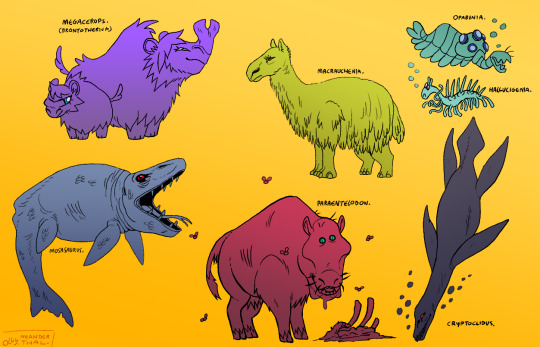
some paleofriends - thanks for the suggestions!
#ollyneanderthal art#illlustration#artists on tumblr#paleoart#prehistoric#paleo#mosasaurus#entelodont#plesiosaur#hallucigenia#opabinia#macrauchenia#brontotherium#megacerops#creature design
270 notes
·
View notes
Text
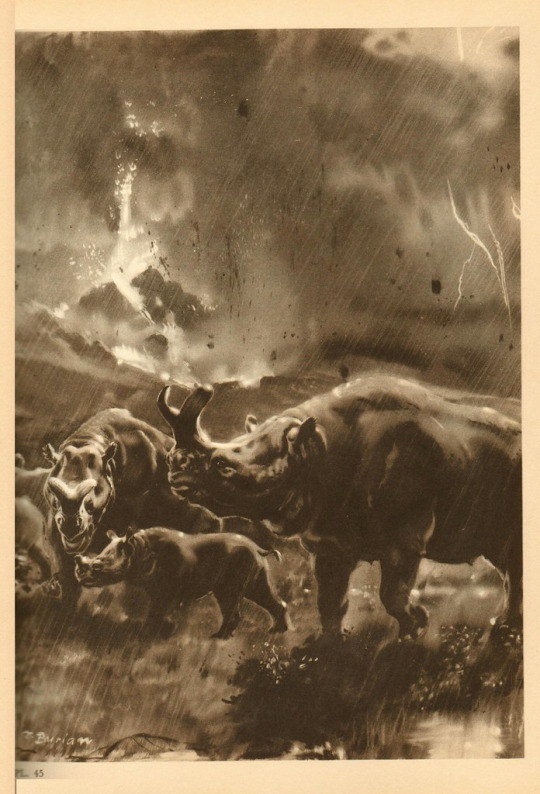
Brontotherium. Zdeněk Burian.
via
136 notes
·
View notes
Photo
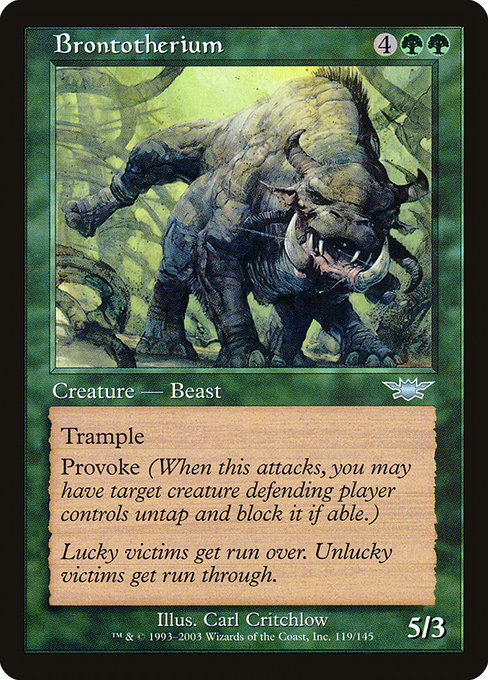
Brontotherium
Lucky victims get run over. Unlucky victims get run through.
Artist: Carl Critchlow
TCG Player Link
Scryfall Link
EDHREC Link
18 notes
·
View notes
Photo

#129 - Unoceros
#fakemon#pokemon#ice type#wooly rhinoceros#rhinoceros#megafauna#ice age#elasmotherium#brontotherium#perissodactyla
143 notes
·
View notes
Text


I've wanted to do an electric Brontothere for ages and since I've got an electric, rhino-adjacent fossil fakemon already in this region, I decided it could make for a good Ancient Power evo instead. As such, Thundercolt was designed as though it could've been a final evo before gaining it's own evolution in a later game (something i've done a few times in this region).
Ponai form small herds, lead by an adult Thundercolt. They don't have the aggressive tendencies of their adult counterparts and so can live together in relative peace, but benefit from their presence to ward off predators. Fast in their own right, their first response is to flee danger but if pressed will fire botls of lightning from their horn.
Thundercolt possess a wild temperament and will squabble when in groups much bigger than three. They adopt herds of Ponai and look after them in return for a more peaceful social solution. As well as firing bolts of lightning with their horns they can sunder the earth with the clatter of their hooves, rumbling both the sky and the land.
Brontremor are heaving beasts of muscle and are indomitable in their will. With such a stalwart defence they have little need to be so grumpy but nevertheless are dangerous pokemon to be around, easily angered and quick to charge. Little can stop them once they begin running and their footsteps are like the breaking thunder.
I was struggling with the poses on these guys so had to do a ref sheet to help me out. Handy to better see their markings too so here it is.
--Attack Info--
--Ability Info--
#tresto#fakemon#fakedex#saucylobster#horse#pony#colt#unicorn#brontotherium#megacerops#brontops#rhinoceros
3 notes
·
View notes
Text
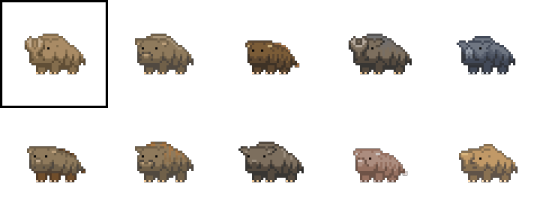
Brontotherium/Megacerops variants for Let's Build a Zoo now with more Brontotheriidae. Original sprite in upper left corner.
2 notes
·
View notes
Text
Monarch Episode 9
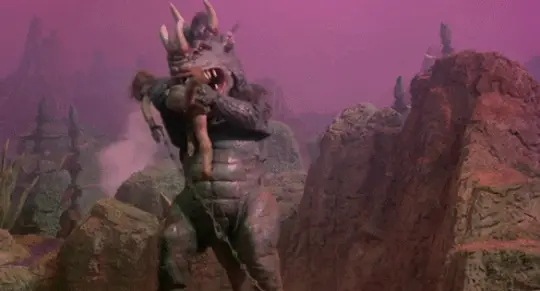
If I had a nickel for every time a piece of monster media featured a warthog-like monster at the center of the earth, I would have two nickels.
If I also had a nickel for every time a piece of monster media that qualified for the prior criteria also had a scientist character trapped at the earths core construct a bow out of local material, I would have four nickels in total.
#kaiju#kaiju tv#monster#monster movie#bramble boar#brontotherium#mastodonosaurus#apologies to anyone looking up actual brontotheres or temnospondyls
1 note
·
View note
Text

Tamuka
Altura: 150 metros
Longitud: 225 metros
Peso: 72,000 toneladas
Primer Avistamiento: Las Vegas [Tierra: Teratoverso]
Controles: Tierra Control [Excavación, Embestida Petrea] Fuego Control [Rayo Incandescente]
Guarida: Area 51 [Tierra: Teratoverso] Base de contención Krypto 01 y areas aledañas [Avatarverso]
Aspecto: Brontotherium
Aliados:
Humanos: Aang, Katara, Soka, Iroh, Zuko, Toph
Kaijus y otras bestias: Godzilla, King Kong, Mothra, Rodan, Anguirus
Enemigos:
Humanos: Ozai y Azula
Kaijus y otras bestias: Kasai Rex
0 notes
Text
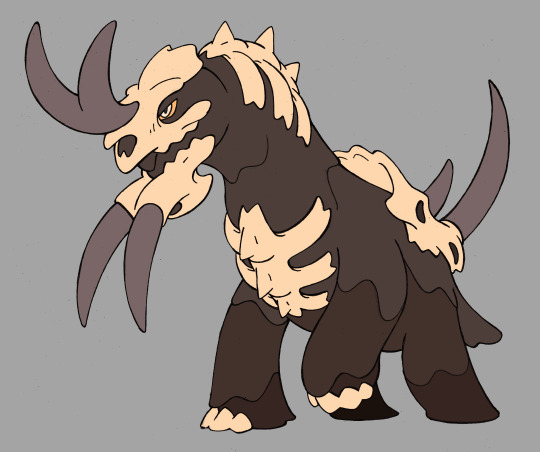
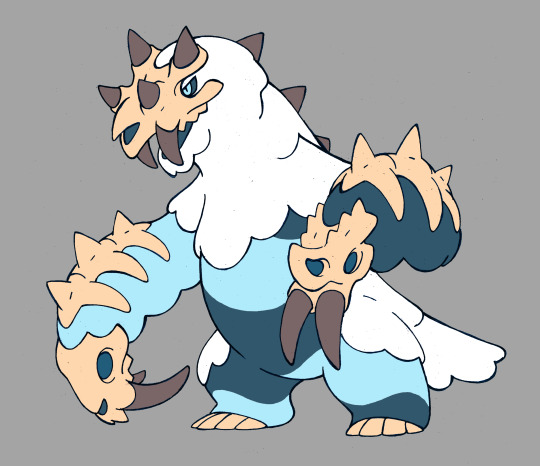
GOLGOLIATH (Ground/Ghost) & CRANIEMBERG (Ice/Ghost)
GOLGOLIATH (Golgotha/Goliath) The tar pit Pokemon.
Its body is made of tar, brought to life by the restless souls of all the pokemon that perished trapped in it. It uses their bones as armor to protect its soft, sticky body.
The shape of its body resembles a Paraceratherium and the skulls from its armor are those of a Brontotherium/Megacerops, a Woolly Mammoth (Upside down) and a Woolly Rhino
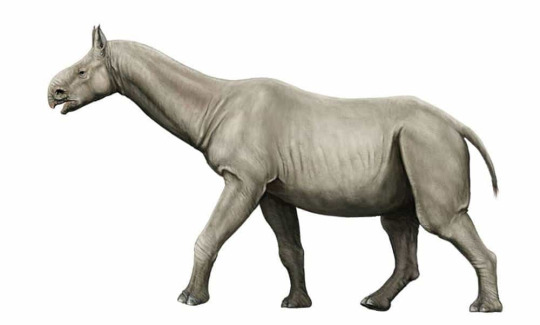
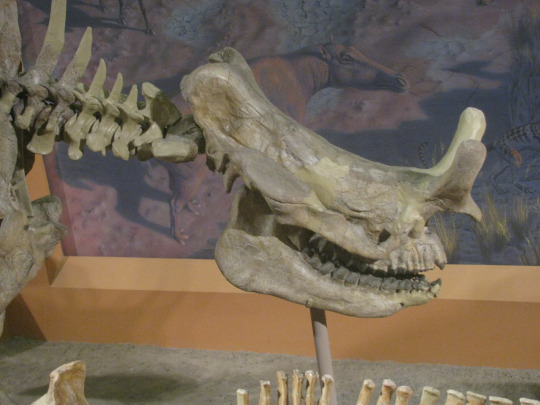

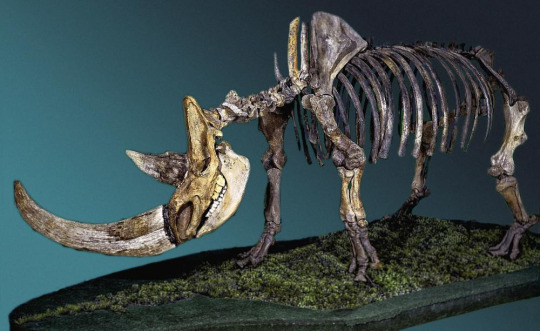
CRANIEMBERG (Cranium/Iceberg/Cronenberg) The glacier Pokemon
Its body is made of Glaciar ice and compacted snow, reanimated by the souls of the many pokemon forever trapped in it. It uses their bones as weapons to hunt for its prey.
Its main body is shaped like a Megatherium and the skulls from its armor are those of an Uintatherium, a Smilodon and an Arsinotherium (upside down)



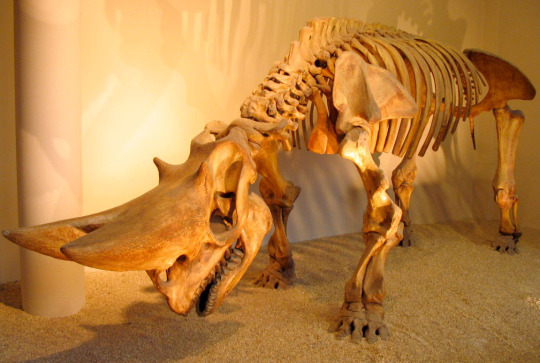
CRANIEMBERG's striped body is based on "Striped Icebergs" a phenomena in which icebergs melt and froze again over time, forming layers of different colors due to the impurities in the water and the difference in densities
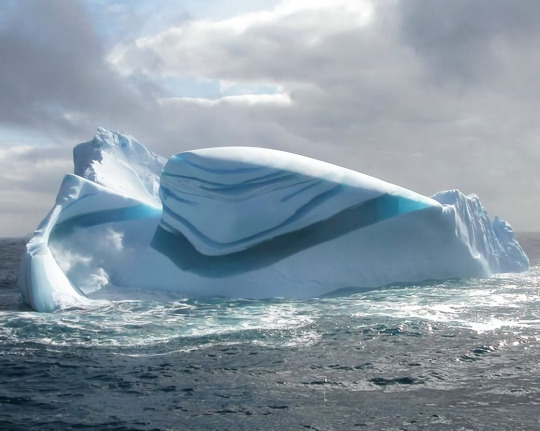



#pokemon#fakemon#fake pokemon#pokemon fossils#tar pits#glacier#iceberg#bones#prehistoric animals#fossils#mega fauna#prehistoric mammals#megafauna#ground type#ice type#ghost type#ice#ground#ghost#ice pokemon#ground pokemon#ghost pokemon#ice fakemon#ground fakemon#ghost fakemon
1K notes
·
View notes
Text
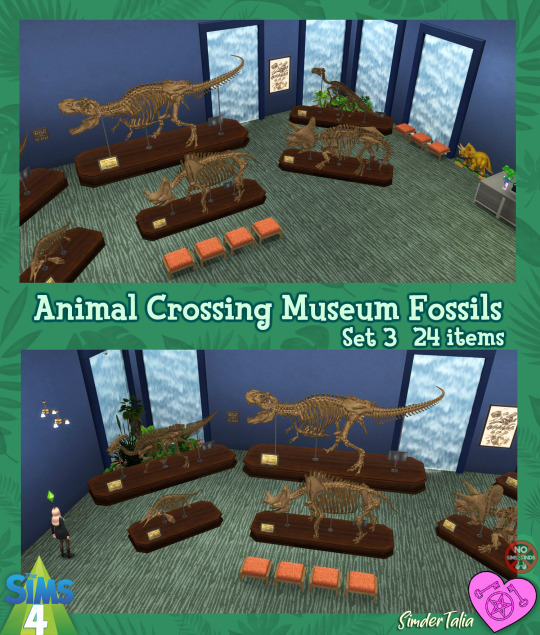

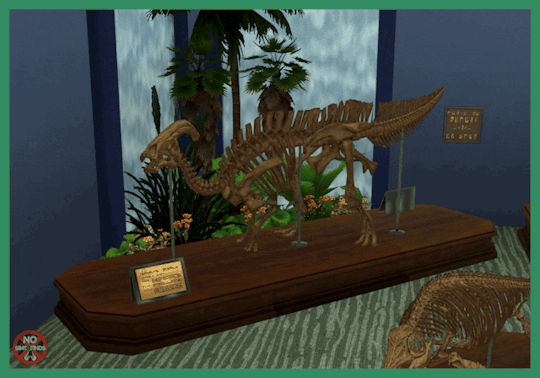


🦕 ACNH Museum Fossils Set 3 🦕
Sims 4, base game compatible. 24 items | Most fossils consist of more than one piece. Just use the bb.moveobjects cheat to line them up. Most of these items are high poly.
I hope you enjoy!
Always suggested: bb.objects ON, it makes placing items much easier. For further placement tweaking, check out the TOOL mod.
Set Contains:
-Brontotherium 1-3 | 1 swatch | 4268, 4176 & 4265 poly
-Diplodocus 1-6 | 1 swatch | 4244, 3914, 4464, 4322, 4102, & 4016 poly
-Iguanodon 1-3 | 1 swatch | 4483, 4380 & 4257 poly
-Ophthalmosaurus 1-2 | 1 swatch | 4261, & 4214 poly
-Parasaurolophus 1-3 | 1 swatch | 4544, 4452, & 4480 poly
-T-Rex 1-3 | 1 swatch | 4247, 4766 & 4024 poly
-Triceratops 1-3 | 1 swatch | 4297, 4503 & 4647 poly
-Placard for tabletops (liberated from platforms) | 2 swatches | 40 poly
Type “acnh museum fossils 3" into the search query in build mode to find quickly. You can always find items like this, just begin typing the title and it will appear.
Download all or pick & choose:
📁 Download all or pick & choose
(SFS, No Ads): https://simfileshare.net/folder/211062/
📁 Alt Mega Download (still no ads): https://mega.nz/folder/tk4h0QSb#b1l7dm4HDpV_ZC9HwNsBFg
📁 Download on Patreon
Will be public on February 17th, 2024 💗
Happy Simming! ✨ If you like my work, please consider supporting me:
★ Patreon 🎉 ❤️ |★ Ko-Fi ☕️ ❤️
★ Instagram📷
Thank you for reblogging ❤️ ❤️ ❤️
@sssvitlanz @maxismatchccworld @mmoutfitters @coffee-cc-finds @itsjessicaccfinds @gamommypeach @stargazer-sims-finds @khelga68 @suricringe @vaporwavesims @mystictrance15
-Museum Fossils Set 1 (public from day of post)
-Museum Fossils Set 2 (public from day of post)
-Pamphlet Holder from Reiki Set
☄️Don’t forget the meteor impact display!
The rest of my CC
#s4cc#ts4cc#sims 4 museum#sims 4 dinosaur#sims 4 archaeology#sims 4 fossil#sims 4 fossils#sims 4 maxis match#sims 4 object#sims 4 historical#simdertalia
140 notes
·
View notes
Text
Bestiaryposting Results: Haesorog
Welcome to this week's bestiaryposting results! This is an unusual one in that the entry is short, but we have plenty of physical details. We're also following up two obvious ones with a description I genuinely think nobody can identify unless they're familiar with the bestiary tradition itself, or the sources thereof.
If any of that was confusing to you, please consult past posts on this matter at https://maniculum.tumblr.com/bestiaryposting. You can also keep up with the current beast of the week -- and participate -- by checking out the tag "maniculum bestiaryposting". The entry that our artists are working from this week can be found here:
Anyway, art below the cut in roughly chronological order:
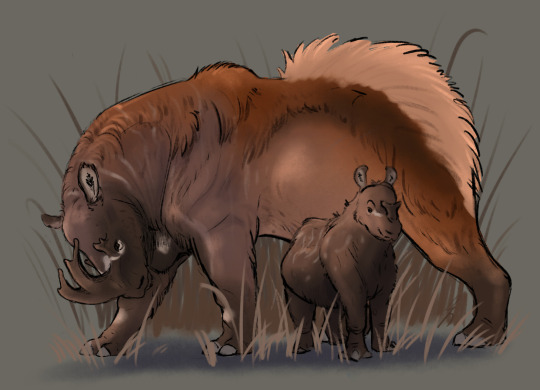
@silverhart-makes-art (link to post here) took this in a rhinoceros kind of direction, drawing something that reminds me of paleoart depicting prehistoric rhino relatives that I have seen & enjoyed. I was going to say something like "I'm not sure if that was the vibe they were going for", but the linked post cites Brontotherium as an inspiration for the horn, so that's probably what I'm picking up on. The depiction of it defending its young makes this a really interesting image, I think; I like it a lot. Also, the design decisions explained in the linked post are genuinely pretty interesting, so I encourage you to check that out.
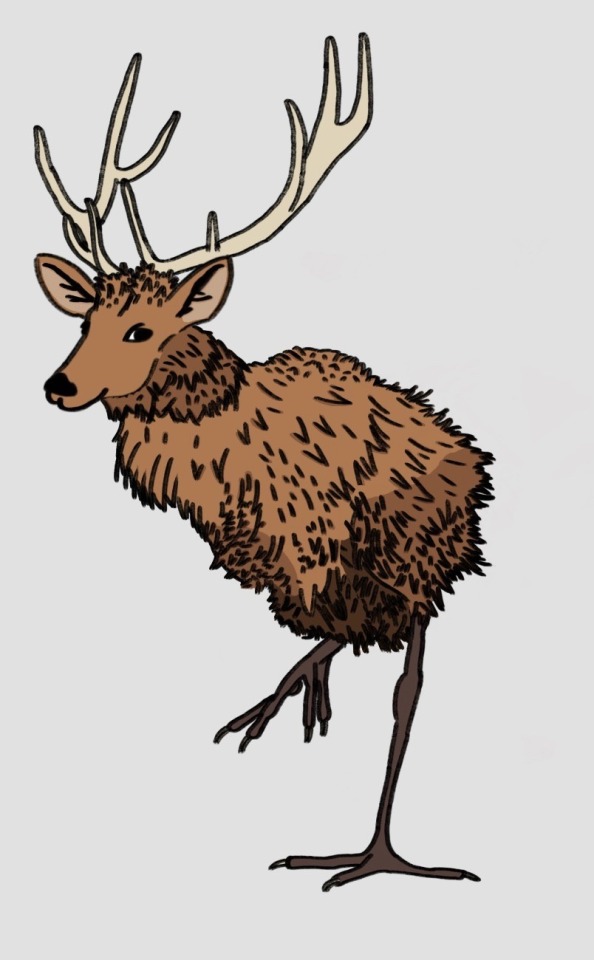
@moonygryffin (link to post here) ran with the "ibis feet, deer head" thing to produce something kind of like a flightless peryton, which I think is pretty cool. What's really clever here, I think, is how the body effectively blends elements of both animals so that it looks like a natural transition between the two. It's kind of bird-shaped, but you can see some deer-shaped elements at the top, and it's got this furry kiwi kind of vibe that's plausibly both "deer" and "bird".
Moonygryffin also suggests that the thing with the feet is the result of our favorite game, Manuscript Telephone, and it was originally the footprint of an ibex, which I think is probably correct. From some quick searching, it looks like Pliny just described this beast as having "cloven hooves". I think it's plausible that a later author changed it for purposes of parallelism -- "size of an ox, fur of a bear, head of a deer, feet of an ibex" -- and then someone else misread it and gave it bird feet. (Do ibexes/ibices* have cloven hooves? I'm going to assume they do, they're goats, right?)
*I checked the OED; both plural forms are attested, though the first is the more common. Which is probably why Tumblr is giving the second one the red underline.

@cheapsweets (link to post here) went for a similar concept as the above, but in a different medium and interpretation. Genuinely impressed by the realistic detail on the legs and head here -- CheapSweets has mentioned seeking out some reference material and art books recently, so I'm inclined to assume those are really paying off. Look at that thing. There's a lot of interesting material in the linked post, speaking to influences, research, and design decisions, which I think is definitely worth checking out. One thing I want to point out specifically because I missed it the first time I saw this drawing: take a look at the people & dog in the background at the top left. Now look at the trees next to them. One of them is a Haesorog cleverly disguising itself. Excellent.
(Also thank you for providing alt text.)
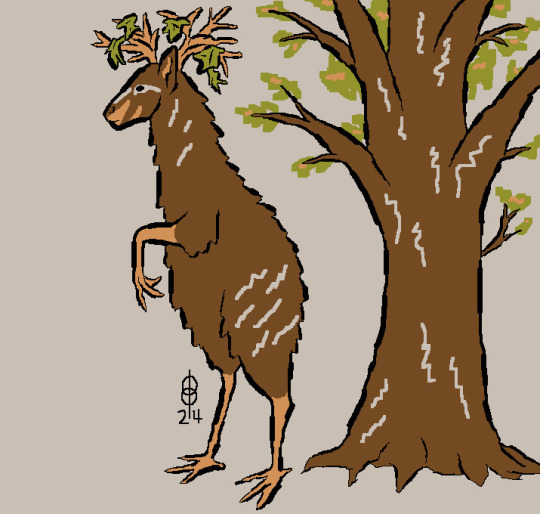
@pomrania (link to post here) has collaborated with @theforceisstronginthegirl on this one, which is a delight! Pleased to see you back, Theforceisstronginthegirl. Anyway, they've also clocked the error with the ibis thing: while they don't suggest it's an error for ibex, they do suggest that it refers to cloven hooves, which as previously mentioned is indeed what Pliny says about it. And then they also decided to give it bird feet anyway because that's more fun, which is very much in the spirit of the thing, excellent call. Anyway, the focus of this design is on the camouflage aspect. They've interpreted it as simply having stellar natural camouflage, which is why it's shown next to a tree here -- we can see that the pattern of its fur lets it blend in with the coloration of the trees around it, and that leaves tangled in its antlers along with its ability to stand on two legs enhances the effect.
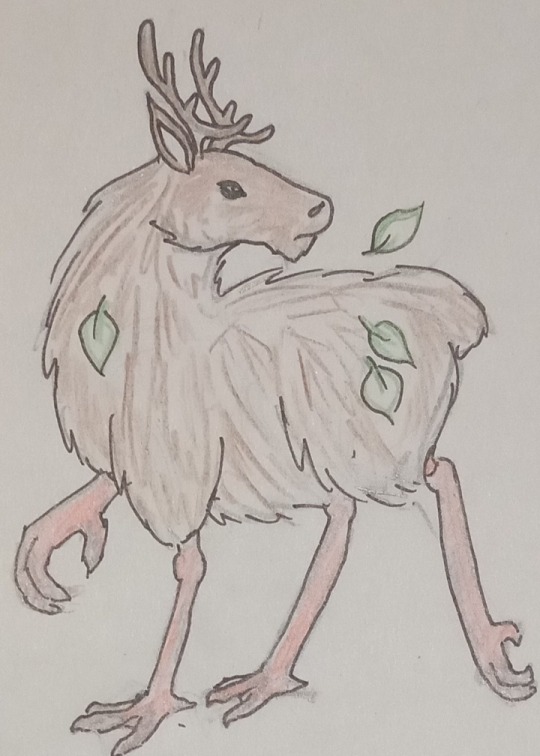
@sweetlyfez (link to post here) went with a similar quadrupedal design, shaggy deer-like thing with bird legs, but went the opposite direction with the camouflage. Her post indicates it's shown here "shedding some leaves from the last time it turned into a bush," which means this version of the Haesorog is suggested to have actively supernatural camouflage that allows it to shapeshift. (Which is definitely suggested by the text.) There's something very evocative about the eyes here, which I like. (Also, thank you for including alt text.)

@coolest-capybara (link to post here) continues to deliver beautifully stylized art. I'm really delighted by the the pose the second Haesorog is taking in order to blend in with the very pretty Stylized Plants around it -- I think this is maybe not the environment where color-shifting is hugely useful, as I have no doubt the first Haesorog is fully aware of its presence. Something that makes this particular design interesting is that between the default coloration displayed on the left and the shape of the feet, you get a kind of "this thing is a step too human for a quadruped" feeling that makes it a little more unique-looking than it might be otherwise. (Also, thanks for including alt text.)
Over all of these entries, I'm noting that one effect of the clear physical description is that it does provide a more restricted space in which artists can play -- it's much more obvious than in other weeks that all of these are the same animal. Whether that's an upside or a downside is, I think, wholly subjective. Now let's look at the Aberdeen Bestiary.
...
Okay, we can't do that actually. The page with the illustration is missing from the Aberdeen Bestiary. So we're looking over to its sister manuscript, the Bodley Bestiary. (MS. Bodl. 764, also digitized online.)
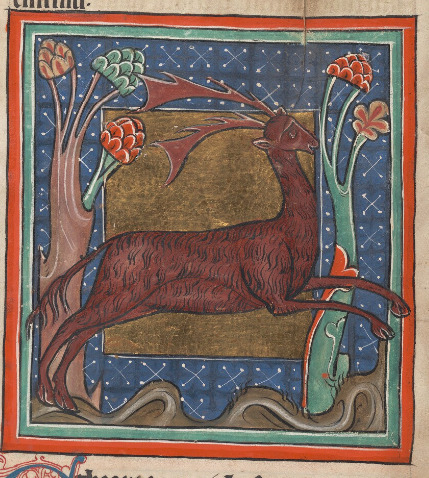
So this beast is of course the Parander.
Yep, bet everyone feels foolish for not recognizing such a common and well-known animal as the parander.
Also, of course, known as the Tarand or Tarander, of course. Or parandrus / tarandrus in Latin.
Right, so the reason that I was so confident nobody without a thorough background in the bestiary tradition (or Pliny the Elder) would recognize this one is because it's not a real animal. And it's not even one of the mythical ones that managed to get a foothold in the modern consciousness.
I might be overstating the "not a real animal" line, actually; odds are good it's based on one. Let's talk about that.
There have been some guesses as to the parander's identity in scholarship. The Bostock translation of Pliny has a footnote that cites two competing theories: "reindeer" and "elk [aka 'moose']". The reindeer one gets an explanation -- differently-colored summer and winter coats -- but the elk one is just kind of tossed out there as a proposed alternative. My guess (based on it already being past 10:30pm here and not wanting to put in the time to track down a source that's cited only by a last name with no other identifying information) is that that one's about the parander's size being emphasized.
You may say, "excuse me Maniculum, neither of those animals lives anywhere near Ethiopia. What are you playing at? Are you going to try and convince me that the pre-modern definition of 'Ethiopia' was so broad it encompassed the Arctic Circle?" The solution is that the parander wasn't originally described as being from Ethiopia -- Pliny says it's from Scythia. Which... also seems a bit too far south. But it's entirely reasonable that the Scythians were reporting on something seen on a trip north or something they heard about from northern neighbors, which would put "reindeer" and "elk/moose" both back in as options. Scythia is close enough to the range of both of those animals that it's plausible they would be familiar with them.
Someone you may have heard of took a stance on this issue, interestingly. An 18th-century biologist named...

... Linnaeus. Yep, it's codified right into the scientific name for "reindeer" now, and has been for as long as binomial nomenclature has been a thing. Anyone who wants to make the "elk/moose" argument is going to have a bit of an uphill battle.
All that out of the way, now take a moment and scroll back up to that medieval illustration. Mentally compare it to the description and the art shared in this post. There's something different, right?
You may notice that the artist has given it cloven hooves rather than bird's feet, having not been confused at all by the "footprints of an ibis" thing. Now, often this is the result of the art not actually being directly based on the text, but copied from art in a previous manuscript, so a scribe can write down the wrong word and it won't affect the art at all because the artist may or may not even be reading the text as they work.
Often, but not always. In this case, I would like to float an alternate explanation.

On the left is the translation of the Bodley Bestiary I have on my shelf, to which I referred when filling in material from missing pages in the Aberdeen Bestiary. On the right is the Bodley Bestiary digitized manuscript.
Now. I am not trained in Latin paleography, so it's possible that I'm misinterpreting an abbreviation. But that word on the right... the penultimate letter certainly looks like a C, doesn't it? Not, e.g., an S? (It would be a long s here, but that doesn't actually help.)
Which means that the manuscript says ibex. The ibex -> ibis confusion is a case of Manuscript Telephone, but it was telephoned in the 1990s.
Again, like I said, I'm not an expert. I've never translated a single page of a Latin manuscript, much less had a book-length translation published in a handsome slipcover edition. So it's very possible I'm missing something. But right now I'm pretty sure that everyone's been drawing bird feet not because of an error made by a medieval scribe, but by the modern translator.
Anyway, that was exciting, right? I hope that makes up for me posting this a few hours later than usual.
53 notes
·
View notes
Text

I have been patiently waiting for any excuse to do an ungulate-animal for Bestiary Posting and when the description for the Haesorog this week mentioned horns I got excited. Ungulates are by far my favorite critters to draw, and they're well known for their ornamental head gear.
Here I'm depicting a defensive mother haesorog lifting her dorsal crest and lowering her head in response to a perceived threat, which her young seems more curious than fearful of.
Originally I was leaning towards an antelope-like animal - particularly a pronghorn, but the 'ibis footprints' made me pause. Ibises have four toes I believe, but I could see their footprints only showing three toes, which means we've got an odd-toed ungulate on our hand. Rhinoceros have three toes, and as a bonus they come with horns! As the haesorog is thick furred, I went with a Sumatran rhino for my jumping off point.
That said, I still wanted an antelope feel, so I made my haesorog more gracile; slimming and shrinking the face and head to be more 'stag-like'; giving it longer, more slender legs; a longer neck; etc. Overall I just wanted a more antelope-like build for my rhino-creature, specifically thinking of large antelope like the Giant Eland (who's dewlap I included but it got a bit lost in the pose).
For it's horns I did consider something closer to a pronghorn, but decided that a nasal horn was just more fun. In order to fit the 'branching horns' description, I went with something like the prehistoric brontotherium horn. I also added some horny eyebrow ridges - just for fun.
For coloration, it's described as being colored like a bear with a thick coat, so I chose a nice ruddy brown fading to grey, with darker legs as you often see in brown bears. It's grey-brown fur is perfect for blending into the rock and scrub of it's home. As it's also said to change appearance when afraid, I decided to give it a dorsal crest that you see in some antelope. The pose is also inspired by nyala, the males of whom put their heads down while they raise their crest to display to other males.
47 notes
·
View notes
Text

Day 27: Beast
Megacerops (formerly known as Brontotherium) is the most bizarre ancient beast of the Cenozoic era.
By the way, did you know why megacerops has a speculative mane on the dorsal along with a under chin beards, it’s mainly because other brontotheres are closely related to horses than to rhinos and tapirs?
5 notes
·
View notes
Text

Meryl Engler, “Lying in Red”, 2023, Woodcut
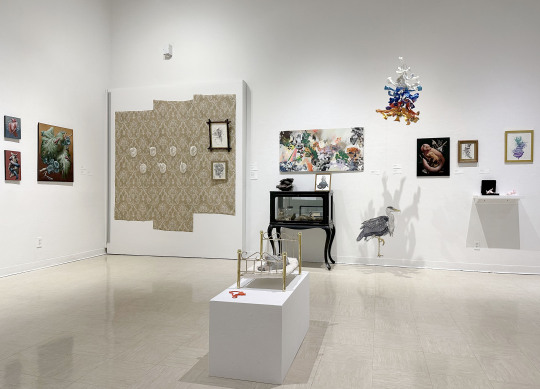

Work by Michael Loderstedt (left), Eva Pozler (center) and Lori Kella (right)
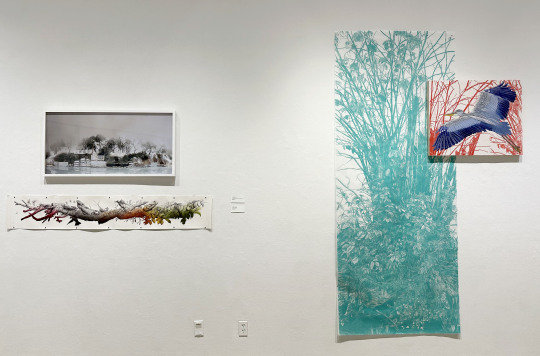
Work by Lori Kella, Maria Uhase, and Meryl Engler (right two pieces)

Lori Kella, “Mudslide and Forsythia”, 2022, Inkjet print (left) and Corrie Slawson, “Amalgam 4”, 2022 (top) and “Amalgam 3”, 2022 (bottom), Oil and screenprint on plywood
Today (4/19/24) is the last day to see Life Out of Balance at the Emily Davis Gallery at The University of Akron. The group show show includes work by Maria Uhase, Meryl Engler, Lori Kella, Benjamin Lambert, Michael Loderstedt, Eve Polzer, Ron Shelton, Ariel Bowman, and Corrie Slawson.
From the gallery-
When a tree falls in a forest, we may see it as the death of the tree. It stops photosynthesizing, growing, feeding its mycorrhizal symbionts, flowering, developing fruit, dispersing seeds, taking in carbon dioxide, and producing oxygen. But in the ecosystem, it begins a whole new life in decay. It feeds the soil and microbes through the decomposition of its tissues; it provides a place for fungi, mosses, and lichens to grow; and it becomes a protected habitat for a myriad of insects, mammals, and birds. This same tree, therefore, can be both dying and living at the same time, depending on perspective. It can be dead if considered separate from its surroundings, or it can be alive in its continued relationship within its ecosystem.
Humans can feel more alive by being integrated with the rest of the natural world. We are not living to our full potential, or allowing nature to be its full potential, when we consider ourselves as separate from it.
If we are to have hope for solving the complex environmental issues that are facing us today, we need to work with, rather than against, the forces of nature.
Below are a few more selections.

Ron Shelton, “Yellow Mosaic”, 2021, Plastic and wire
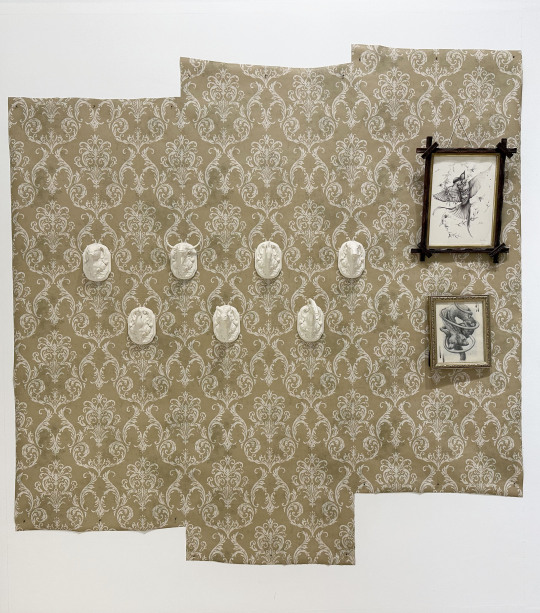
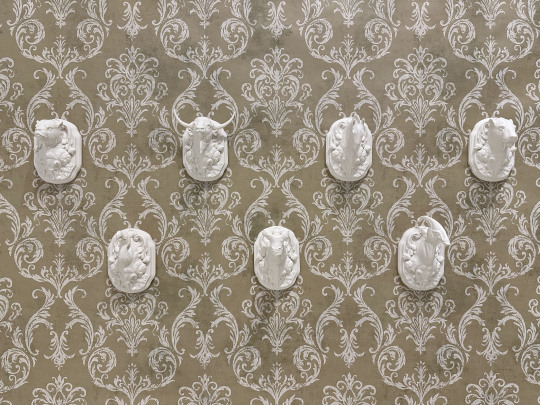
Ariel Bowman, “Wall Trophy Series”, 2019, (Cave Bear, Antique Bison, Early Horse, Saber Cat, Dodo, Brontotherium, Parasaurolophus), Unglazed, high fired porcelain; Maria Uhase, “Splitting Headache”, 2022 Ink on paper and “Softly”, 2023, Graphite on paper

Benjamin Lambert, “A pint for a gallon”, 2020 and “I Found Your Damn Lost Shaker of Salt”, 2020, Stoneware, underglaze, glaze, epoxy
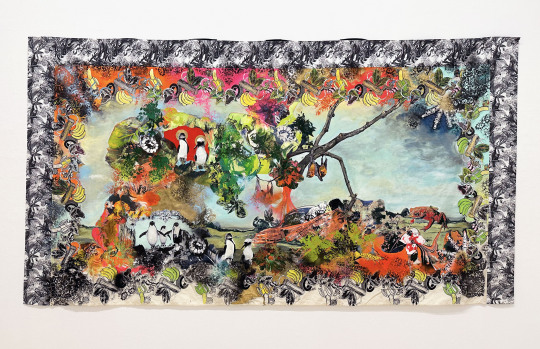

Corrie Slawson, “Stage Set Tapestry 1, for Feast: a ballet. Of Bats, Blue Footed Boobies, Penguins and other threatened fauna and flora. Pastoral landscape after Rubens”, 2020, Oil and mixed media on muslin
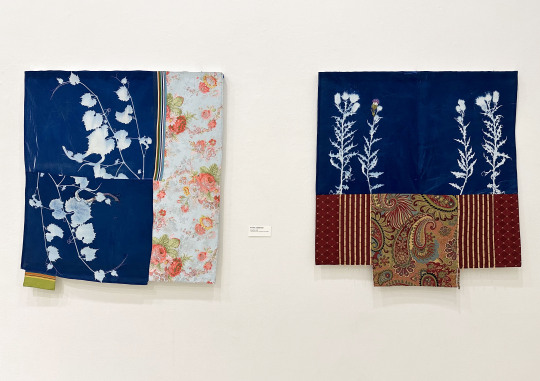
Michael Loderstedt, “Snakehead”, 2023, “Thistles”, 2023, Cyanotypes on fabric, embroidery, fabric collage

Lori Kella, “Mayflies in the Grass”, and “Yellow Irises”, 2024, Framed inkjet prints
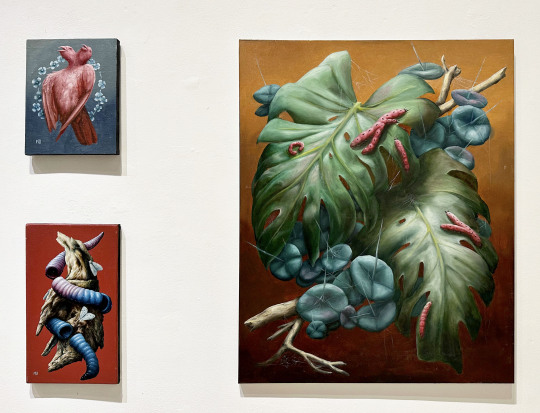
Maria Uhase, “Encircled”, 2023, Oil on linen panel, “Worm”,2023, Oil on linen and “Conglomeration in the Spiders’ Ghost Town”, 2020, Oil on canvas

Eva Polzer, “Gift from a Cat”, 2024, Ceramic, underglaze, velvet jewelry box, and “Gift from a Rat”, 2024, Ceramic, underglaze, petri dish

Meryl Engler, “Waiting”,2023, Woodcut Block
#The University of Akron#Emily Davis Gallery#Akron Art Shows#Ariel Bowman#Meryl Engler#Ron Shelton#Eve Polzer#Art#Michael Loderstedt#Maria Uhase#Art Shows#Lori Kella#Benjamin Lambert#Ceramic Art#Ceramics#Corrie Slawson#Cyanotype#Cyanotypes#Environmental Art#Environmental Photography#Fabric Art#Fabric Collage#Fiber Artist#Fiber Arts#Nature Photography#Ohio Artist#Ohio Artists#Painting#Photography#Printmaking
0 notes
Photo
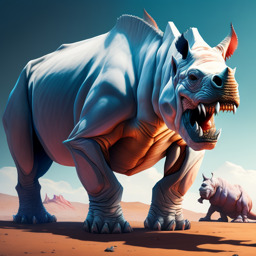

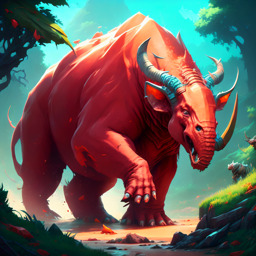
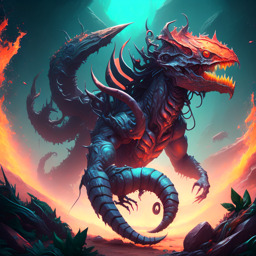


Using A.I (Art Generator)
In Order from 1 - 6
1. Carnotaurus & white rhinoceros
2. Gigantoraptor & Tropeognathus
3. Megacerops/Brontotherium & Platybelodon
4. Trilobite & Titanoboa
5. Naked Mole Rat & five-toed worm lizard
6. Indian peafowl & Hummingbird
0 notes
